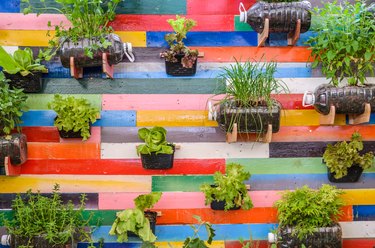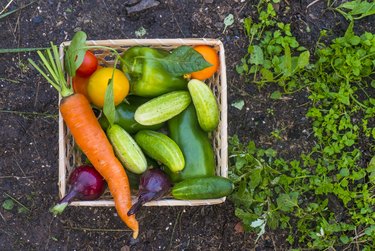
In an ideal world, your backyard is an expression of the life you want—whether it becomes party central, a zen retreat or even a productive, refrigerator-filling vegetable garden. A standard-size suburban lot offers plenty of scope, but what if you have a small backyard?
While small spaces require a bit more planning, there's no reason you can't make them magical. To get you started, we've got a few backyard landscaping ideas and tips to help incorporate outdoor space—however tiny—into your lifestyle.
Video of the Day
Video of the Day
1. Pick plants for small spaces

In addition to size, some backyards are problematic for reasons of shade, drainage or other specific issues. The good news? There are plants available for almost any growing situation. To get you started, here's a quick list of plants that work well in small gardens and other less-than-ideal growing situations:
Plants that tolerate shade: Hostas, ferns, caladium and coleus (both of which offer red and green foliage), hydrangeas, lungwort, astilbe, impatiens, primulas and forget-me-nots.
Plants that tolerate drought: Echinacea (coneflower), California poppy, lavender, yarrow, buddleia (butterfly bush), artemisia, ornamental alliums, coreopsis, baby's breath, creeping thyme, hen and chickens, and many other succulents.
Plants that tolerate damp soil: Sweet woodruff, rose mallow, hibiscus, astilbe, swamp azalea, summersweet, Siberian or Japanese irises, joe-pye weed (pollinators love it!), cardinal flower and ligularia.
Plants that tolerate/prefer acidic soil: Hydrangea, azaleas and rhododendrons, daffodils, nasturtiums, gardenias, most conifers (good news if you want decorative cypress or juniper), holly and most viburnums (purely decorative varieties and their berry-bearing cousins, including blueberries and high-bush cranberries).
Know Your Soil
Knowing what kind of soil you have is an important starting point when creating your backyard oasis, and at-home tests can help with this. From there, you can amend your soil or choose plants that will flourish in what you’ve got. If your soil is really bad, you’re better off embracing container gardening and raised beds.
2. Create a focal point
In small yards, it helps to create a focal point that will anchor your design. This might be a fire pit, water feature, birdbath, sculpture or even an eye-catching tree, shrub or flower bed. Other design decisions can be made around what best serves that focal point.
Consider the layout of the rest of the space too. Be choosy in laying out beds and containers, as well as other permanent features from hardscaping (pavers, retaining walls) to an arbor or pergola. Giving your plants the best possible growing conditions is an important consideration, but you'll also need to be aware of how traffic flows through your space. It's helpful to test ideas as you go, using furniture, trash cans, rope or anything else that's handy as stand-ins to mark out where these physical structures will be placed. Make sure everything is sized appropriately and doesn't feel claustrophobic.
3. Split the space

It sounds counterintuitive, but splitting up a small space into areas with different functions can make it feel larger simply because there's more to do and see. Create visually separate areas—perhaps an outdoor room with a seating area, a mini veggie garden or a play space for the kids—with permanent installations or your choice of blossoms and greenery.
A graveled garden path, some inexpensive edgers or the sides of raised garden beds all work well for marking out spaces. So do plantings of tall flowers or shrubs, and (of course) hardscaping features like a paved walkway or a retaining wall. Retaining walls can double as extra seating, as can raised beds if you build a bench along one side.
4. Soften lines & corners
Small spaces are prone to feeling boxy. One step in turning yours into the backyard oasis of your dreams is to soften corners and break up straight lines that create this impression. Plant flower beds or tall shrubs in corners and mulch around them to create gentle curves, semicircles or kidney-shaped areas.
Gently curving beds along either side can help, especially if you have a narrow "bowling alley" yard. In fact, curving part of your flower bed to make a small "peninsula" can help create the illusion of having separate spaces without the cost (and immobility) of physical structures.
Get to Know Your Garden Style
In small yards, you’ll need to be protective of every inch. Start by reflecting on your personal style: Do you like crisp lines and clearly defined spaces or a more organic, free-flowing look? Do you want your space to complement existing home decor or are you seeking contrast? How do you feel about color, texture and scent? Do you prefer privacy and seclusion or clear sight lines to maximize views? Would you like a decorative space or one where you can grow herbs and vegetables? (You can do both in the same space, by the way, and we’ll get to that.) Survey your preferences, then move on to picking your plants.
5. Consider texture & color

Many elements go into making a yard or garden eye-pleasing. Color is the most important, but height and year-round appearance are important too. Aside from showy blossoms, look for foliage that's glossy and velvety or crinkled or creased (and often, as with coleus, beautifully colored in its own right).
Succulents work well in hot, direct sun that would parch many other plants, creating a pleasing contrast (you can put them in planters of their own if you want to feature them between moisture-loving plants). Staggering the height of plants also helps, with taller plants furnishing a visual backdrop for those in front of them.
6. Embrace vertical space
Fences don't just mark the line between your property and the neighbors'—they're also a blank canvas for backyard design. You can mount planters (DIY or store-bought) to your wall to create a vertical garden or screw sturdy brackets to posts and decorate with hanging baskets. You can do the same with a pergola or arbor, training vines up and over or festooning them with hanging plants. Of course, if you have a killer view, try not to block it!
7. Include grass alternatives
Grass is the default way to cover ground in both back and front yards, but it's not always the most practical option. Grass requires constant care, but lower-care options make a valuable addition to garden landscaping. These can include creeping ground covers, areas of bark mulch outlining beds or areas where grass is replaced by fine gravel, in the style of Japanese gardens. Even artificial turf can be a pragmatic option, especially if you live somewhere that experiences water shortages in summertime. (Turf options have improved a lot over the past couple decades.)
8. Add veggies & herbs

Single planters: If your notion of gardening entails growing a perfectly ripened tomato or digging into salad greens all summer, that's possible in even the smallest garden space. You can fit a functional herb garden—or a highly productive tomato plant—into a single planter. If your space constraints aren't quite so dire, incorporate a few beds of herbs and veggies.
Conventional beds: Raised beds or small in-ground vegetable gardens can go anywhere they'll get enough sunlight. (Most herbs and vegetables flourish best in full light, though some will tolerate a bit of shade, especially in hot and sunny climates.) If you don't want them to be visible from your outdoor living space, tuck them behind privacy screens or taller shrubs and grasses.
Vertical plantings: Another way to enjoy huge productivity in a small space is to go vertical with vegetables. Indeterminate tomatoes grow on tall, lanky vines and will produce nonstop until frost kills them. Growing them on a trellis, tower or up a fence post provides productivity in small spaces. You can do the same with pole beans or runner beans (the latter are edible, though they're mainly grown for blossoms) and even cucumbers or zucchini.
Edible Landscaping
If you’re really pressed for space and have decided to focus on a flower garden and ornamentals, it’s still possible to sneak in a bit of vegetable growing through edible landscaping. This simply means planting vegetables and herbs in places where they’ll serve a decorative purpose and complement annuals, perennials and shrubs. A few fun examples:
Chives: With vivid purple blossoms, they make an appealing flower bed accent.
Hanging strawberry plants: Decorative in their own right, especially day-neutral varieties that flower and fruit all summer.
Colorful mini peppers: Whether sweet or hot, they're decorative in beds or planters.
Physalis (aka ground cherries or “golden berries”): Beautiful in their paper husks, resembling ornamental Japanese lantern.
Cherry tomatoes: Many varieties produce heavy clusters of colorful fruit in cheery reds, yellows and oranges. Grown up a trellis, they make a distinctly decorative element amid foliage plants.
Let’s not forget that many decorative plants, from daylilies to nasturtiums to lesser-known herbs like borage, are perfectly edible as well.
Now that you've got plenty of inspiration for your small (but mighty!) garden space, it's time to start designing and preparing to plant. Before you know it, you'll be basking in the fruits (or should we say veggies?) of your labor.